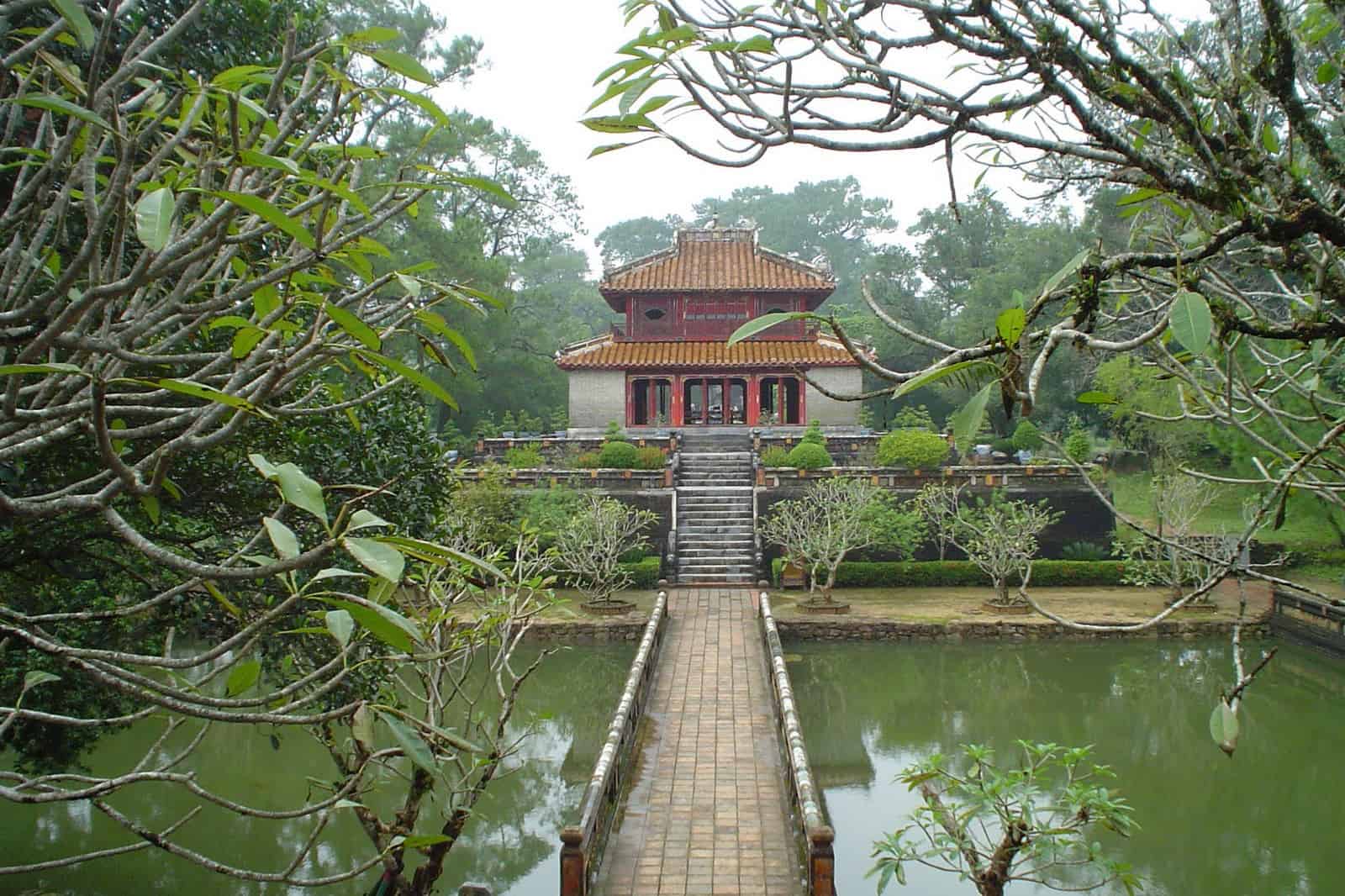Hue
Why Hue, Vietnam Should Be on Every Traveler’s Bucket List
Looking for a destination that blends imperial grandeur, cultural soul, and unforgettable flavors? Hue, Vietnam is a must-visit city. Once the imperial capital of the Nguyen Dynasty, Hue preserves its rich history through majestic citadels, ancient shrines, and royal tombs — all nestled along the poetic Perfume River.
What sets Hue apart from other cities in Vietnam is its deep-rooted connection to Vietnamese royal heritage and intangible cultural traditions. From the mesmerizing performances of Nha Nhac – royal court music (a UNESCO-recognized art form) to graceful dances and heartfelt folk songs, the city’s cultural pulse is alive and well.
As you wander through the city, you’ll often spot elegant Vietnamese women in flowing Ao Dai (traditional long dresses) and conical hats, adding timeless beauty to Hue’s quiet streets and riverbanks.
But Hue isn’t just about history — it’s a culinary capital of Central Vietnam. Food lovers will fall in love with iconic local dishes like Bun Bo Hue (spicy beef noodle soup), Banh Beo (steamed rice cakes), and other royal-inspired delicacies you won’t find anywhere else.
Travel Guide
1. How to Get to Hue: Transportation Guide for Travelers
1.1. Best Ways to Reach Hue
Wondering how to get to Hue, Vietnam? Whether you’re flying in from Ho Chi Minh City, Hanoi, or landing internationally in Da Nang, reaching this imperial city is a breeze. Here are your top travel options:
-
By Plane: Hue’s Phu Bai International Airport (HUI) connects seamlessly with major cities like Hanoi, Ho Chi Minh City, and Da Nang. It’s the quickest way to reach Hue and is just 30 minutes from the city center. Look out for budget domestic flights that make Hue more accessible than ever.
-
By Train: The Reunification Express runs through Hue and is perfect if you want to soak up Vietnam’s countryside. Traveling by train is not only scenic but also affordable and eco-friendly—great for slow travel enthusiasts.
-
By Bus or Car: If you’re on a backpacker’s budget or planning a multi-city road trip, buses and private cars from Da Nang, Hoi An, or even Ninh Binh offer a cost-effective way to explore the region.
-
✨ Hot Tip: Search for “how to travel from Da Nang to Hue ” or “best way to get to Hue Vietnam” to see current schedules and travel times.
1.2. How to Get Around Hue Like a Local
Once you’ve arrived, Hue offers a variety of transport options to match every travel style—from cultural wanderers to thrill-seekers.
🚗 Private Car or Taxi
If comfort and convenience are top priorities, consider hiring a private car with driver for the day. It’s a popular choice for travelers exploring the Royal Tombs or venturing to Thien Mu Pagoda. Metered taxis and Grab (Vietnam’s Uber) are also widely available and reliable.
🛵 Motorbike or Scooter Rental
One of the most authentic ways to explore Hue is by motorbike. Renting a scooter gives you the freedom to discover hidden pagodas, countryside roads, and even ride along the Perfume River. You can ride solo or book a driver for a safer experience.
🚶♀️ Walking the Historic Core
Hue’s central area—especially around the Imperial Citadel and Perfume River—is best explored on foot. Walking tours or self-guided strolls offer a slower pace to take in Hue’s poetic ambiance, ancient temples, and colonial architecture.
2. Best Time to Visit Hue: Seasonal Travel Tips
Planning when to go to Hue? Here’s what to know before booking your trip:
-
November to March is the sweet spot: Hue is cooler and drier, making it ideal for exploring historic sites without breaking a sweat. Temperatures range from 18°C to 25°C.
-
April to August brings hotter, humid weather—perfect if you enjoy sun-drenched adventures or are traveling during summer holidays.
-
Rainy season (September–October) can bring occasional storms, but Hue still offers indoor cultural experiences like royal music performances and traditional tea ceremonies.
Places Of Interest
The Imperial Citadel of Hue: A Timeless Treasure of Vietnam’s Royal Heritage
Step into the heart of Vietnam’s imperial past at the Imperial Citadel of Hue – a must-see UNESCO World Heritage Site and one of the most iconic historic landmarks in Vietnam. Constructed in 1804 under Emperor Gia Long, this sprawling royal complex once served as the political and cultural capital of the Nguyen Dynasty, Vietnam’s last feudal rulers.
Inspired by the grandeur of Beijing’s Forbidden City, the Hue Citadel was meticulously designed with three protective layers: the Capital Citadel (Kinh Thanh), the Royal Citadel (Hoang Thanh), and the Forbidden Purple City (Tu Cam Thanh). Within these ancient walls stood grand palaces, mandarin halls, serene temples, and royal libraries – all testaments to the architectural mastery and spiritual richness of 19th-century Vietnam.
Today, although much of the site was damaged during the Vietnam War, restoration efforts have brought many structures back to life. Visitors enter through the monumental Ngo Mon Gate, one of the best-preserved features, and can explore stunning reconstructions like the Thai Hoa Palace, To Mieu Temple Complex, and the Royal Theatre (Duyet Thi Duong).
Spending just a few hours here offers a deeply moving glimpse into Vietnam’s royal legacy. Whether you’re a history buff, a cultural traveler, or a photography enthusiast, the Imperial Citadel of Hue is an unmissable destination on your journey through Central Vietnam.

Discover the Tomb of Emperor Minh Mang: A Masterpiece of Imperial Hue
Looking for the most majestic royal tomb in Hue? The Tomb of Emperor Minh Mang stands out as one of Vietnam’s most awe-inspiring imperial sites. Nestled within a lush landscape and rich in symbolism, this royal mausoleum perfectly balances power, nature, and spiritual harmony.
Located where the Perfume River gracefully branches into two, the tomb’s site was handpicked to reflect the emperor’s legacy and the principles of Feng Shui (Phong Thủy)—with mountains as guardians at the back and water flowing in front to welcome prosperity and peace. This design mirrors the emperor’s wish to rest eternally in balance with nature.
More than just a tomb, it’s a cultural and architectural gem of the Nguyen Dynasty. Stroll through serene lotus ponds, cross ancient stone bridges, and admire intricate red-and-gold pavilions—each feature telling stories of Minh Mang’s powerful reign and visionary spirit.
📌 Hot tip for travelers: Visit early in the morning for the best light for photography and a more peaceful experience. Don’t miss the sunrise mist floating over the lake—it’s surreal.
Why Visit the Tomb of Minh Mang?
-
🏯 Iconic Nguyen Dynasty architecture
-
🌄 Breathtaking Feng Shui-aligned setting
-
📷 Top photography spot in Hue
-
🧭 Essential stop on any Hue royal tomb tour
-
🚤 Easily reachable via a scenic boat trip on the Perfume River

Khai Dinh Tomb Hue: A Must-Visit Royal Masterpiece in Vietnam
Tucked away in the lush Chau Mountain Range just outside Hue, Khai Dinh Tomb stands as the last—and arguably the most intricate—royal tomb of the Nguyen Dynasty. Often overlooked by mainstream tourists, this hidden gem in Hue is a striking fusion of East and West, where Vietnamese imperial design meets French Gothic and Romanesque influences.
Surrounded by rolling hills covered in pine and sugar cane, the tomb feels almost like a painting brought to life. Its construction spanned eleven years, completed in 1931, and its ornate detailing—from blackened concrete facades to dragon mosaics and vibrant ceiling frescoes—makes it a top cultural attraction in Hue.
Whether you’re a history lover, an architecture enthusiast, or simply a traveler seeking off-the-beaten-path things to do in Hue, Khai Dinh Tomb offers a truly one-of-a-kind experience that showcases the grandeur of a fading empire.

Thien Mu Pagoda – A Must-See Spiritual Icon on the Perfume River
When searching for top things to do in Hue, Thien Mu Pagoda consistently tops the list — and for good reason. Perched gracefully on the banks of the serene Perfume River, this ancient temple offers not only spiritual depth but also some of the most Instagrammable views in Hue.
Built in 1601, Thien Mu Pagoda is most famous for its Phuoc Duyen Tower, a striking seven-story stupa that rises 21 meters into the sky. Each level of the tower represents a layer of Buddhist cosmology, making it a meaningful symbol for both pilgrims and travelers seeking cultural insight.
One of the most unforgettable ways to visit Thien Mu Pagoda is by taking a Hue boat tour. Gliding along the Perfume River on a traditional sampan boat, you’ll approach the temple from the water, just as Vietnamese royalty once did — a peaceful and photogenic journey that feels like stepping back in time.
Whether you’re exploring Hue’s spiritual heritage, seeking a peaceful river escape, or simply hunting for beautiful places in Vietnam, Thien Mu Pagoda offers a uniquely tranquil and enriching experience.

Discover Thanh Toan Village: A Hidden Gem in Hue’s Countryside
Just 8 kilometers from the heart of Hue, Thanh Toan Village offers a serene escape into Vietnam’s authentic rural lifestyle. Nestled among lush green rice paddies and quiet country paths, this peaceful village is a must-visit for travelers seeking an off-the-beaten-path experience in central Vietnam.
Unlike the bustling tourist hubs, Thanh Toan Village immerses visitors in the tranquil charm of Hue’s countryside, where traditional farming life unfolds amidst timeless landscapes. Whether you’re cycling past buffalo-dotted fields, visiting the iconic Thanh Toan tile-roofed bridge, or chatting with friendly locals at the morning market, this is where the true soul of rural Vietnam comes alive.
Perfect for those searching for unique things to do in Hue or planning a cultural day trip, Thanh Toan promises both relaxation and insight into local traditions.
Lang Co Beach: Hidden Gem in Vietnam’s Coastal Paradise
Lang Co Beach, often considered an underrated gem, is a must-visit for travelers seeking tranquility and natural beauty. Known for its crystal-clear waters and a stunning, unspoiled stretch of white sand, this serene coastal paradise offers a perfect escape for beach lovers and nature enthusiasts alike. The breathtaking beach is framed by lush green hills, creating a mesmerizing backdrop that ensures a memorable experience.
Located conveniently along the Hai Van Pass, between the vibrant city of Da Nang and the historic town of Hue, Lang Co Beach is easily accessible and a rewarding stop for anyone exploring Vietnam’s central coast. Whether you’re looking to relax by the water or indulge in water sports like kayaking and jet-skiing, Lang Co provides a variety of activities for every type of traveler.
Best Time to Visit Lang Co Beach
To enjoy Lang Co Beach at its best, plan your visit between March and May when the weather is warm and the skies are clear. It’s best to avoid visiting during August and September, as this period marks the start of the stormy season in the South China Sea, which may disrupt beach activities.

Suggested Itineraries





